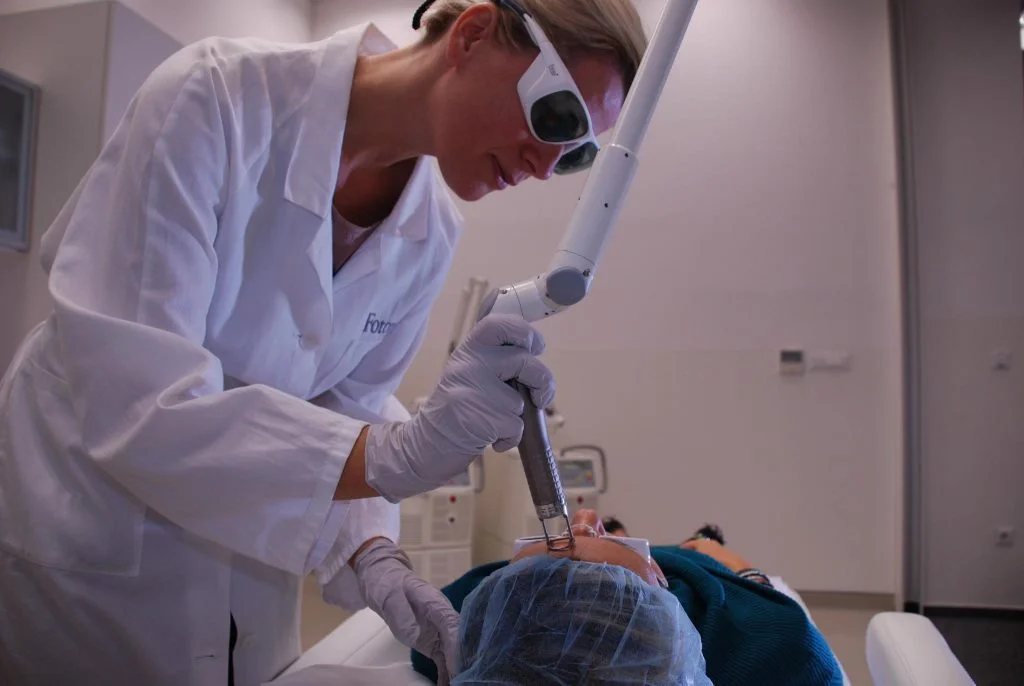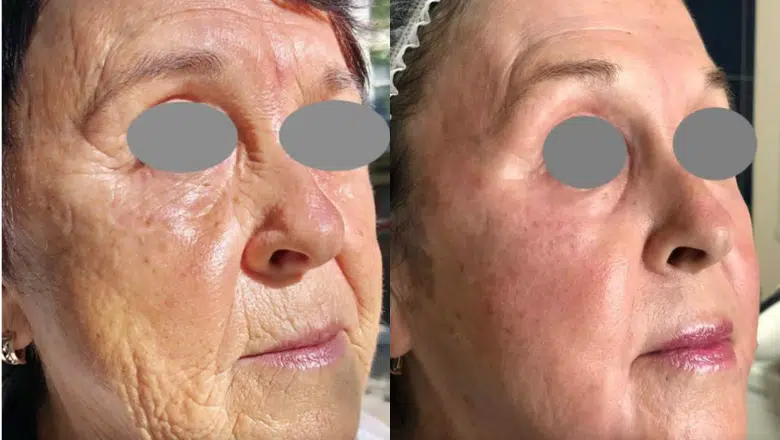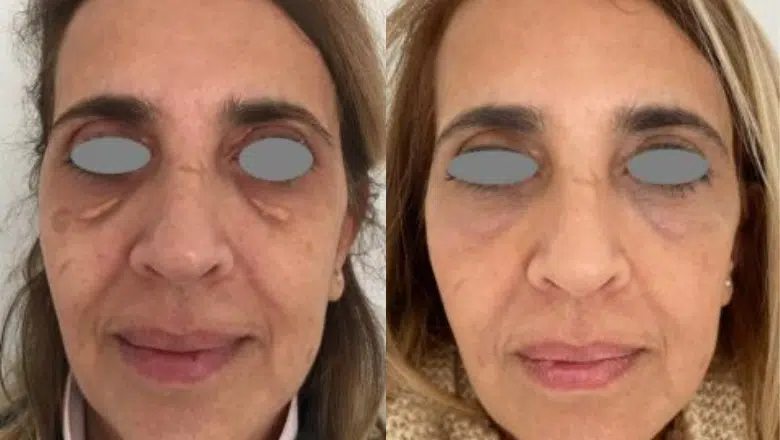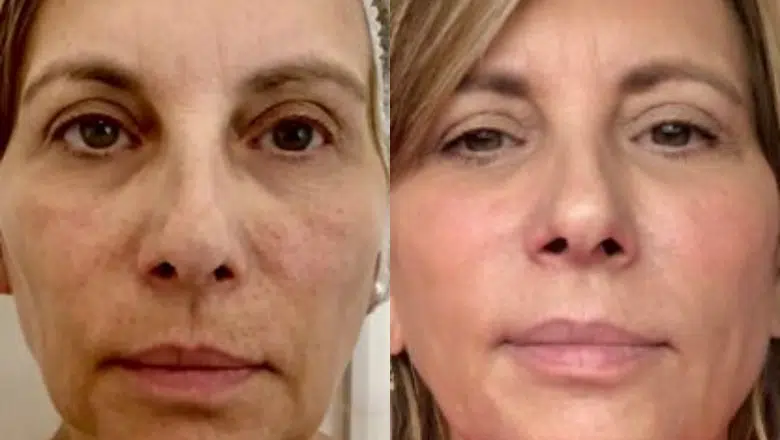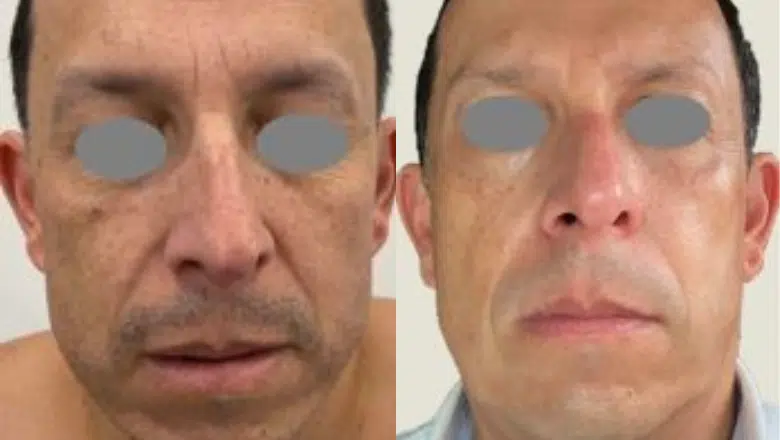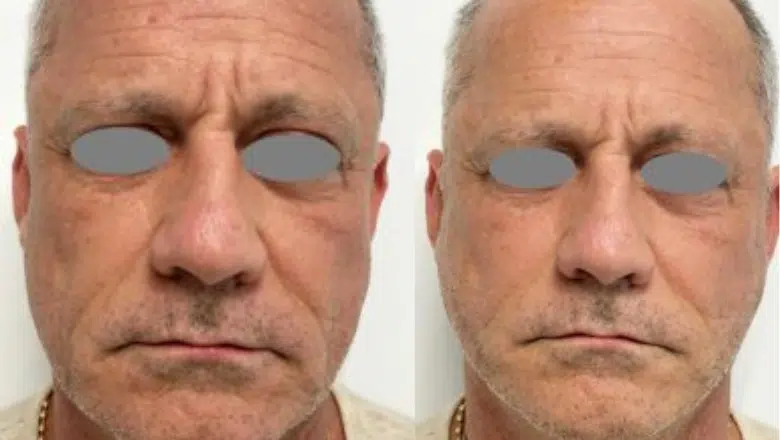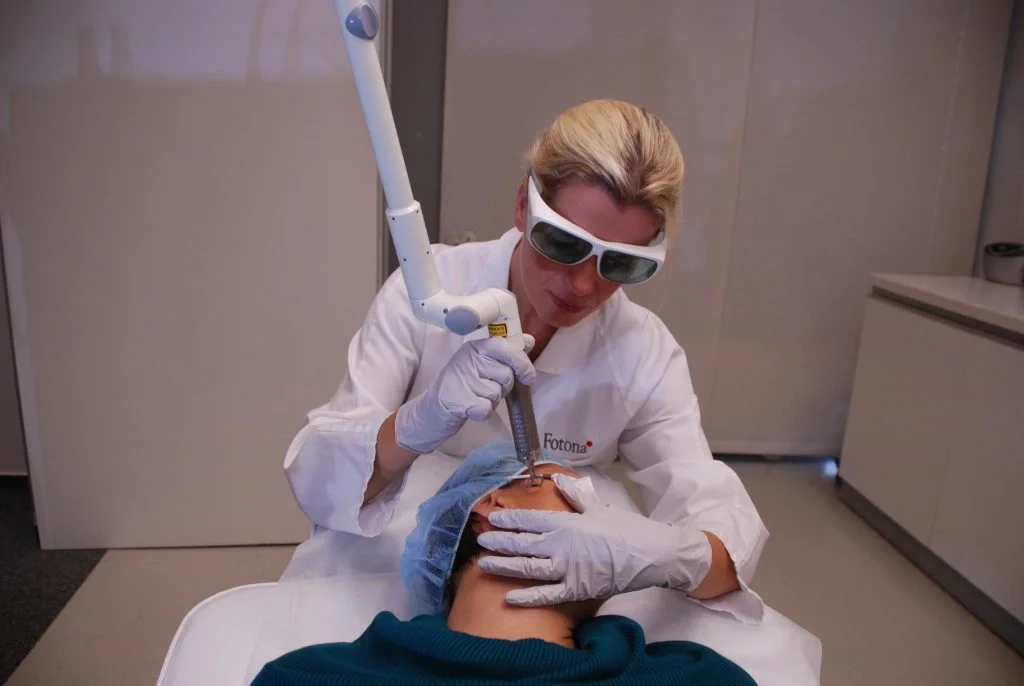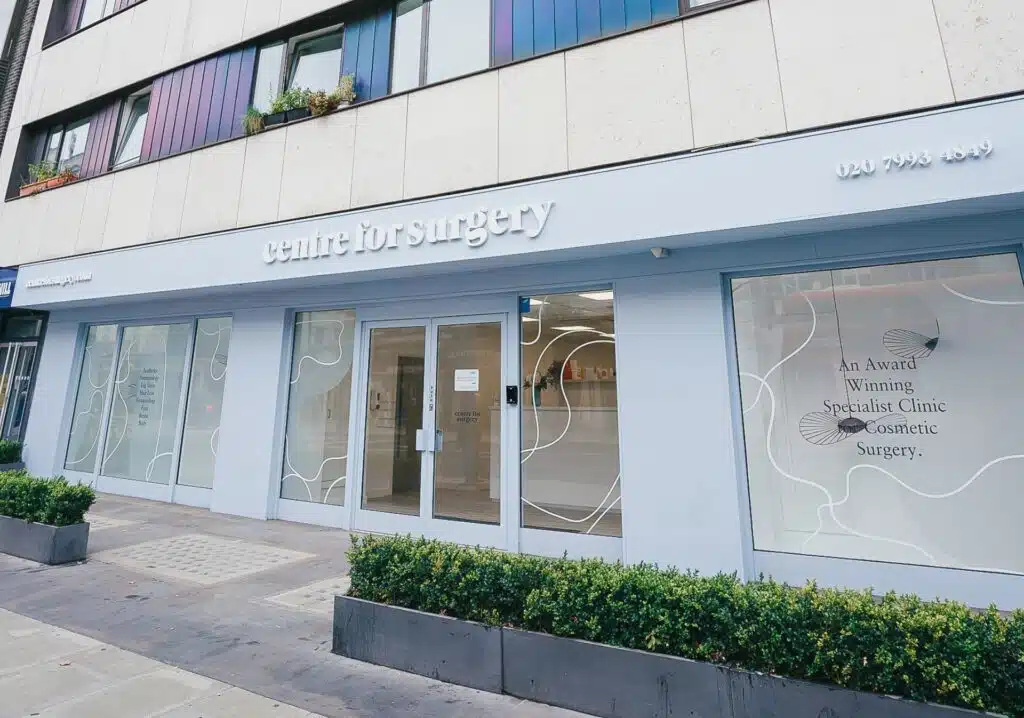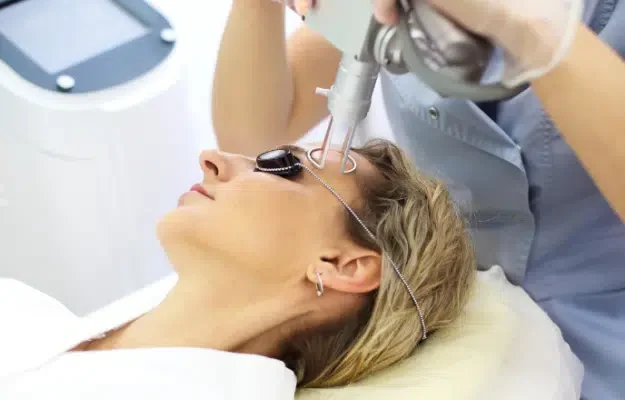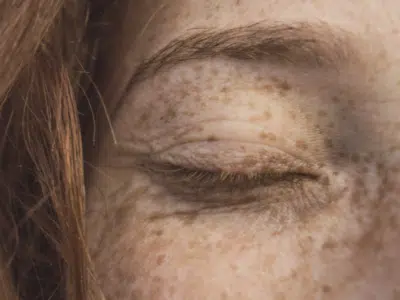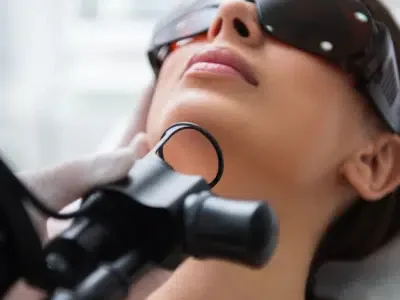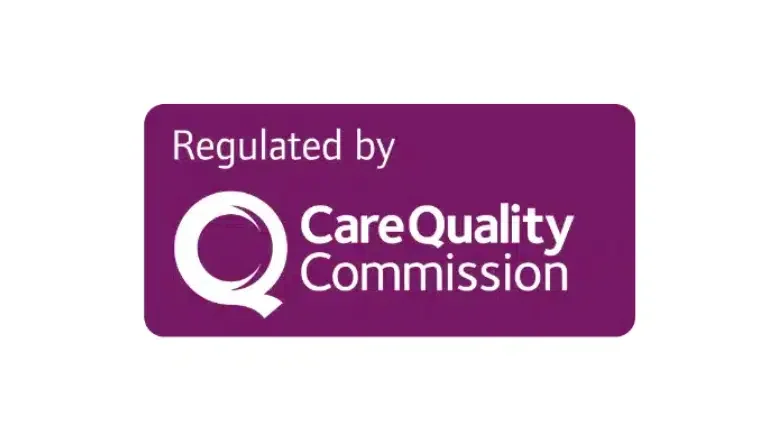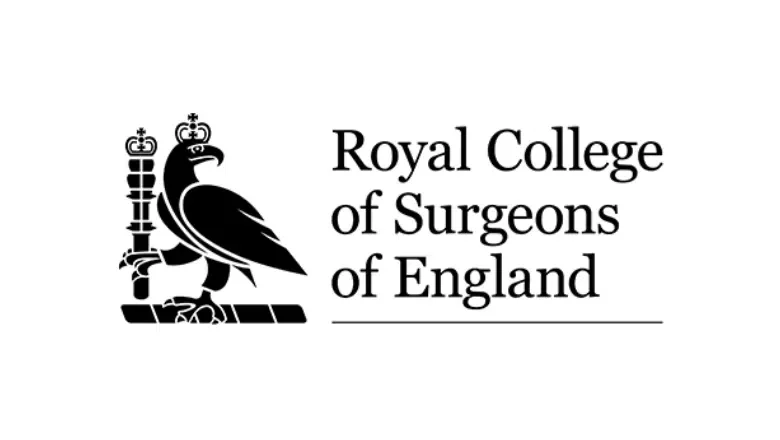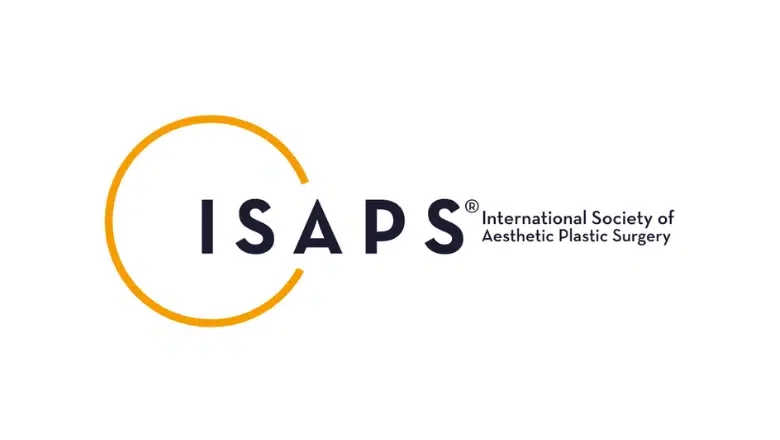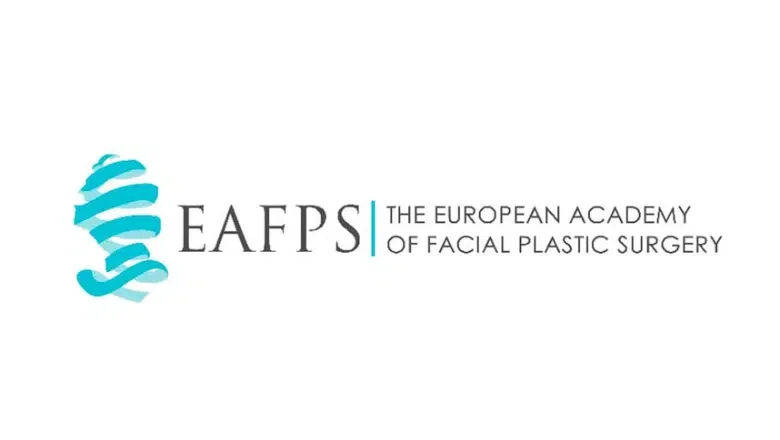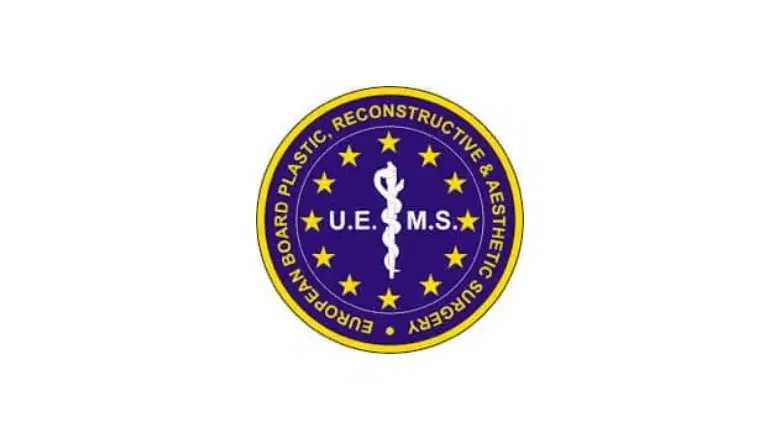Laser Skin Resurfacing in London
Er:YAG Laser Resurfacing for Skin Rejuvenation and Youthful Complexion
Laser resurfacing, also referred to as laser peel or fractional laser resurfacing, harnesses the power of the Erbium laser to rejuvenate sun-damaged skin. This advanced technique effectively removes the outer layer of damaged skin, resulting in a smoother, softer, and more youthful appearance. Laser resurfacing is a groundbreaking alternative to traditional methods like chemical peels and Morpheus8, addressing a myriad of skin concerns, including fine lines, wrinkles, facial scarring, rough skin texture, hyperpigmentation, age spots, acne scarring, and discolouration. Typically performed on the face and neck, laser resurfacing offers remarkable results in just a single treatment, with long-lasting effects that can endure for years.
The Recovery Process
Following laser resurfacing, patients can anticipate an average recovery period of 7-14 days. During this time, it is imperative to minimize sun exposure, wear protective clothing, and use high-SPF sunscreen to reduce the risk of hyperpigmentation. Our dedicated practitioners will also prescribe top-tier medical-grade skincare products, facilitating the healing process and optimising both your recovery and final results.
Expected Outcomes
- Reduction or elimination of fine lines and wrinkles
- Treatment of age spots, sun spots, and solar lentigo
- Treatment of acne scarring
- Treatment of dyschromia
- Elimination of coarse skin texture
- Skin tightening
- Removal of freckles
Over time, the effects of sun damage and environmental pollutants accumulate, leading to the formation of wrinkles, age spots, sun spots, and unsightly blemishes.
Choosing the Right Specialist
Selecting the right specialist for your laser treatment is paramount in achieving exceptional results. At Centre for Surgery, we prioritise surgical-grade lasers over ‘aesthetic grade’ alternatives, which often carry higher risks of complications. Our practitioners possess extensive experience, performing numerous laser procedures annually. Entrust your skin to specialists with profound expertise in powerful surgical-grade lasers and access to cutting-edge laser technology.
The Power of Fotona Lasers
Fotona lasers are renowned worldwide for their exceptional quality and precision. Er:YAG laser resurfacing using the Fotona SP Dynamis is a superb treatment option for a wide range of common skin concerns. From localised treatment of benign pigmented lesions such as seborrhoeic keratosis or senile warts to full-field resurfacing of the entire face, this laser emits light at a peak wavelength of 2940nm. This wavelength targets water absorption in the superficial skin layers (epidermis and dermis). It enables epidermal ablation and subsequent skin healing, effectively addressing sun-induced damage, dyschromia, and rough skin texture.
Stimulating Collagen and Elastin Production
Moreover, the added thermal injury in the dermis below the ablation zone stimulates collagen and elastin production. This leads to a reduction in skin laxity and an improvement in the appearance of static wrinkles, also known as wrinkles at rest. With careful patient selection and Er:YAG laser treatment, you can achieve a significantly enhanced overall skin appearance.
Suitability for Different Skin Types
While Erbium laser skin resurfacing is most effective for lighter skin types (Fitzpatrick skin types I-II), it can also be adapted for darker skin types (Fitzpatrick skin types III-IV) by adjusting the laser settings to more conservative levels.
Comprehensive Treatment Approach
At the Centre for Surgery, we offer a holistic approach to skin rejuvenation. In addition to Er:YAG laser resurfacing, we provide combination treatments involving Morpheus8, anti-wrinkle injections, and dermal fillers, tailored to your unique needs. Trust us for a radiant, youthful complexion that stands the test of time.
What is Laser Skin Resurfacing?
Laser skin resurfacing is a cosmetic procedure that utilises laser technology to enhance the appearance of the skin. This innovative technique involves directing concentrated, pulsating beams of light at irregular skin, meticulously removing skin layer by layer. This process is also known as lasabrasion, laser peel, or laser vaporisation.
At the heart of this procedure is the precision with which the laser operates, allowing for targeted treatment of specific skin issues. Laser skin resurfacing primarily aims to reduce facial wrinkles, scars, and blemishes. Additionally, it’s remarkably effective in improving overall skin tone and texture.
The procedure involves two types of lasers: ablative and non-ablative. Ablative lasers, which include erbium lasers, work by vaporising the top layers of damaged skin. This intense treatment leads to more significant downtime but dramatically improves skin quality.
Non-ablative lasers, on the other hand, don’t remove any skin layers. Instead, they aim to stimulate collagen growth and tighten the underlying skin. This approach is less invasive and typically requires less recovery time, making it a preferred choice for individuals seeking a less intensive treatment.
During the procedure, the practitioner focuses the laser device on the desired area, emitting short, concentrated beams of light. This light removes the outer layer of the skin (epidermis) while heating the underlying skin (dermis). This dual action removes damaged surface skin and stimulates the growth of new collagen fibres. As the treated area heals, the new skin forms smoother and firmer.
Candidates for laser skin resurfacing typically have fine lines or wrinkles around their eyes, forehead, or mouth, scars from acne or other causes, or skin that needs repairing due to sun damage or ageing effects. It’s a highly tailored procedure, so a consultation with a skincare professional is essential to determine the best approach based on individual skin type and cosmetic goals.
Recovery times vary depending on the type of laser used and the extent of the treatment. Ablative treatments might require two to three weeks of healing, whereas non-ablative treatments generally have a shorter recovery period.
Like any cosmetic procedure, laser skin resurfacing has potential risks, such as infection, scarring, and changes in skin pigmentation.
Laser Skin Resurfacing Before and After
Benefits of Laser Skin Resurfacing
At Centre for Surgery, laser skin resurfacing in London is performed using state-of-the-art VSP Erbium technology. This involves high-power surgical-grade laser resurfacing the skin with extreme precision. Erbium: YAG lasers with a wavelength of 2940nm create less injury to the deeper lying dermis and have less risk of inducing hyperpigmentation skin changes compared with the CO2 laser when the Erbium laser is used in a pure ablation mode, which leads to quicker healing.
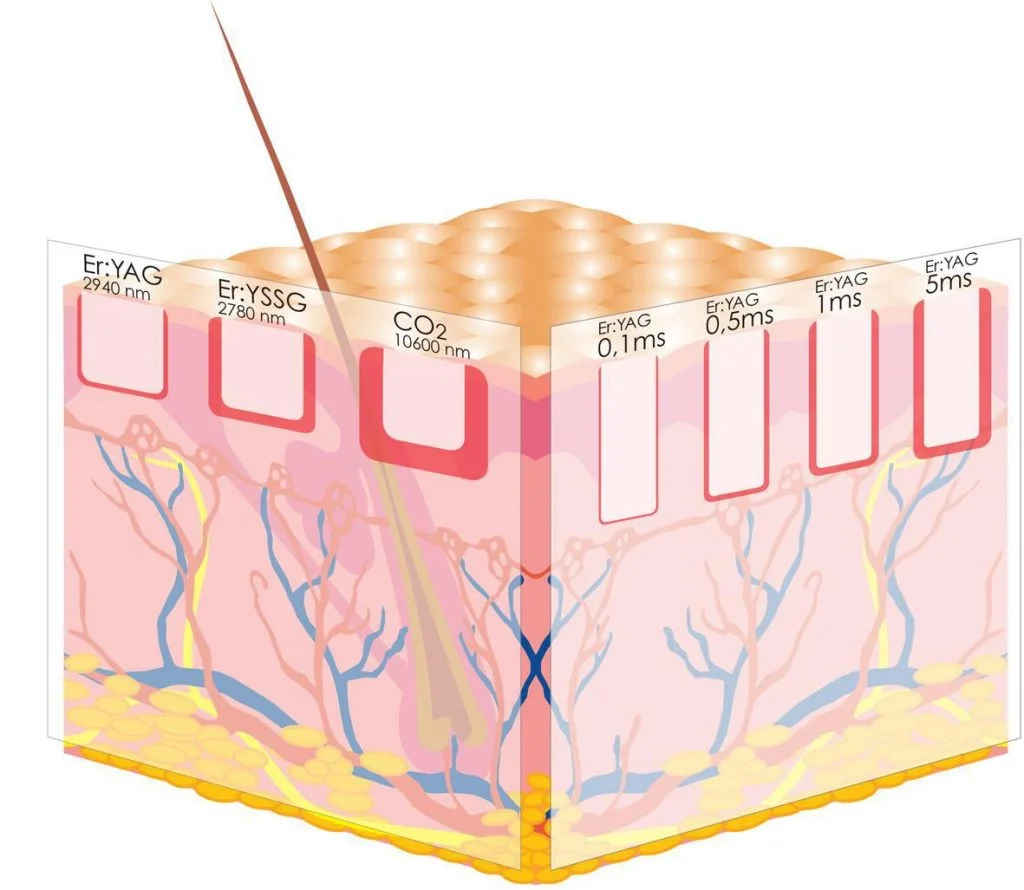
In recent years, the fractional CO2 laser has been developed to reduce the impact of thermal injury. Fractionation of the laser beam into lots of microcolumns lessens the impact on the skin. The disadvantage of fractional CO2 lasers is their effect of leaving areas of untreated and aged skin. The fully ablative Erbium laser allows for complete ablative skin resurfacing with much less energy being imparted to the dermis and, therefore, less risk.
There are numerous benefits to undertaking laser skin resurfacing, including:
- Able to rejuvenate the skin without surgery or the use of chemicals
- Suitable for any skin type
- Reduced downtime
- Allows for precise and accurate control during treatment, giving you the best results
Ablation and coagulation – how do these matter?
Er:YAG laser is very well absorbed in water. Water is the primary chromophore for ablative lasers like the older CO2 lasers and the newer Er:YAG lasers. CO2 lasers have less ablation efficiency due to their lower absorption in water. Er:YAG laser is much more efficiently absorbed in water than CO2 lasers. This allows our lasers to vaporise the target tissue of skin with extreme micron-level accuracy without undesired thermal coagulation effects. These collateral thermal effects seen with the CO2 laser are very often responsible for post-inflammatory hyperpigmentation or PIH, persistent erythema (redness), and prolonged recovery times. Coagulation will always accompany ablation with CO2 lasers – not so with Er:YAG technology.
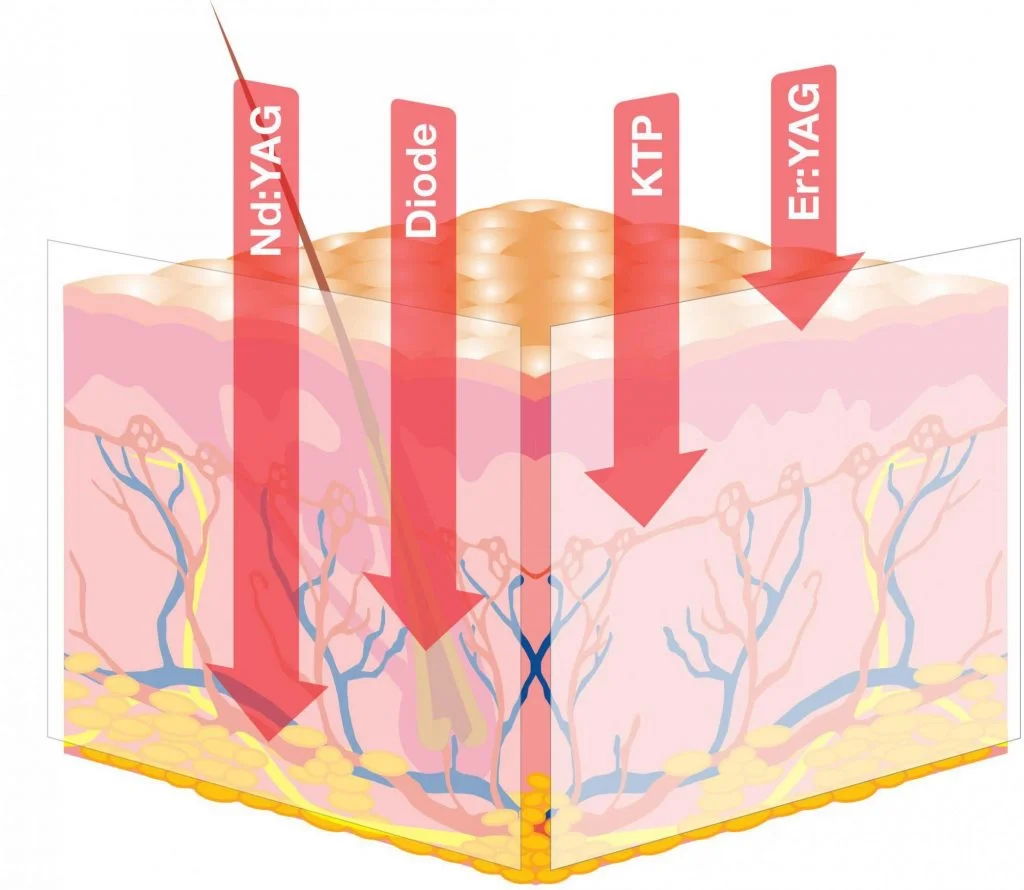
The dual mode Erbium allows the operator to fine-tune the ratios between Er:YAG ablation and coagulation all the way from ‘cold’ ablation to non-ablative coagulation. The versatile nature of dual-mode Erbium laser technology is now the standard of care for laser skin resurfacing.
Erbium laser resurfacing is best suited for patients with lighter Fitzpatrick 1 and 2 skin types. As part of a skin preconditioning routine, all patients must apply topical skin products 2–3 times per week for 4–6 weeks and stop seven days before laser treatment. A one-week course of 500 mg of antivirals four times daily is started one day before the procedure.
Non-ablative laser resurfacing using Erbium Glass laser is better suited for patients with Fitzpatrick skin types 3-5.
Am I Suitable for Laser Skin Resurfacing?
Fractional erbium laser skin resurfacing is a suitable procedure for those who are concerned about fine lines, wrinkles, skin texture or acne scars. It is suitable for those who do not wish to undergo a surgical procedure and do not want to use any chemicals . You will need to be at least 18 years old to undergo the laser resurfacing procedure.
You will need to attend a consultation with one of our aesthetic practitioners, who will be able to assess whether or not you are a suitable candidate for laser resurfacing.
Good candidates for laser resurfacing
- Patients with lighter skin types – Fitzpatrick types 1-3
- Those who would like to reduce fine lines around the periocular or perioral region
- Tightening of loose skin of the upper and lower eyelids as an alternative to a blepharoplasty
- Those wanting to reduce hyperpigmentation, age spots or freckles
- Treatment of facial scars, including all types of acne scars
- Are in good overall health with realistic expectations of what laser resurfacing can achieve
- Non-smokers
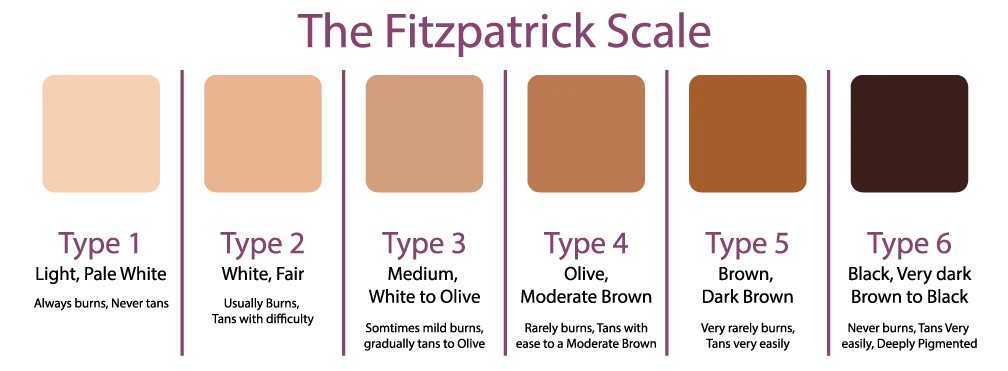
How to Prepare for Laser Skin Resurfacing
Our practitioner’s preference is to pre-treat all patients for 4–6 weeks before laser resurfacing. This regimen includes topical skin-lightening agents and sunscreen with an SPF greater than 30. The pretreatment protocol improves skin tolerance, regulates fibroblast and melanocyte function, improves dermal circulation, and allows for the treated skin to heal 3–4 days faster due to increased cellular division and new collagen formation. Modifications to this pre-procedure regimen (dosages and application intervals) are made as needed based on tolerance and skin types. A week before the laser resurfacing procedure, patients are started on a cleansing and toning protocol and encouraged to maintain adequate hydration and regular skin moisturising. Antiviral prophylaxis is started two days before the laser resurfacing procedure and continued for five days after the laser skin resurfacing in patients with a prior history of herpes virus. Oral antibiotics may also be prescribed after the procedure to minimise the risk of bacterial infection.
Before laser resurfacing, removing all makeup and skin lotions from the face is important. You should avoid all forms of tanning, including tanning beds and excessive sun exposure, for at least four weeks before the procedure. The aftercare instructions are based on the type of laser treatment administered and should be followed to avoid complications. Intense physical activity should be avoided for at least one week. You should avoid exposure to the sun for at least four weeks after the laser resurfacing procedure and up to 6-8 weeks for fully ablative laser resurfacing. Check with your doctor before applying sunscreen, as it can irritate the skin and will be raw after treatment. Your practitioner can advise on the correct timing for sunscreen application.
Laser Skin Resurfacing Procedure
There are two approaches to laser skin resurfacing: fully ablative and fractional.
In fully ablative resurfacing, the entire surface area of the skin within the laser spot is treated by the laser beam. The laser beam is scanned across the treatment area using specialist laser scanners and precisely removes the superficial layers of the skin – micron by micron. During the healing phase, the old, ageing, and sun-damaged skin that is removed will be replaced with a fresh, healthy-looking layer. Regarding penetration depth, treatments can range from superficial light peels to deep peels reaching beyond 100 microns. Light peels are indicated to remove fine lines, sun spots and aged-looking skin; deep peels are applied to improve skin tone and texture and eliminate deep wrinkles, even notoriously hard-to-treat smoker’s lines and crow’s feet. Light peels have a shorter downtime, but deeper peels have more dramatic treatment effects. It depends on your downtime tolerance with some of the deeper laser treatments.
In fractional resurfacing, the laser creates tiny pinpoint columns of skin within each laser spot, leaving intact, unaffected tissue around each micro-spot. This promotes faster healing compared with fully ablative full-field resurfacing, while the laser can be allowed to penetrate the deeper skin layers to initiate collagen and elastin remodelling. This also works very well for acne scarring.
The laser skin resurfacing involves three steps:
- Conditioning: an Ng: YAG laser is passed along the skin’s surface twice, penetrating the tissue and conditioning the skin.
- Fractional therapy: the fractional Er: YAG laser is used to ablate old skin, allowing for new, tighter tissue to form.
- Peeling: the full light Er: YAG laser ablates the skin, removing any superficial imperfections on the skin.
Types of laser resurfacing:
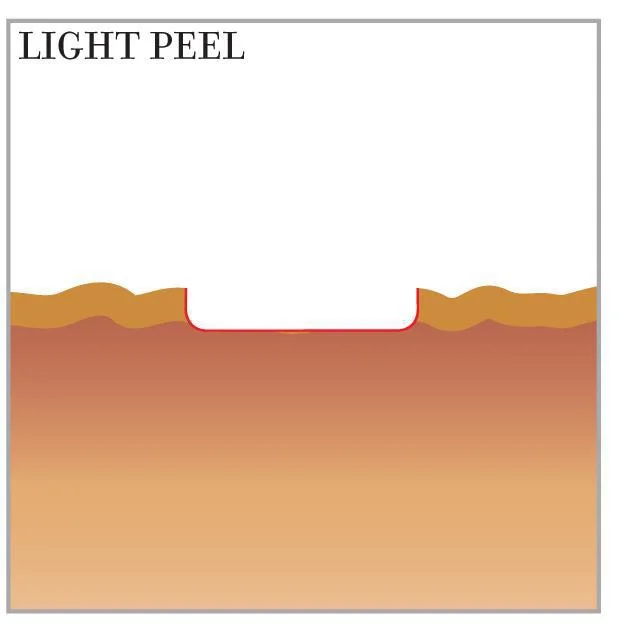
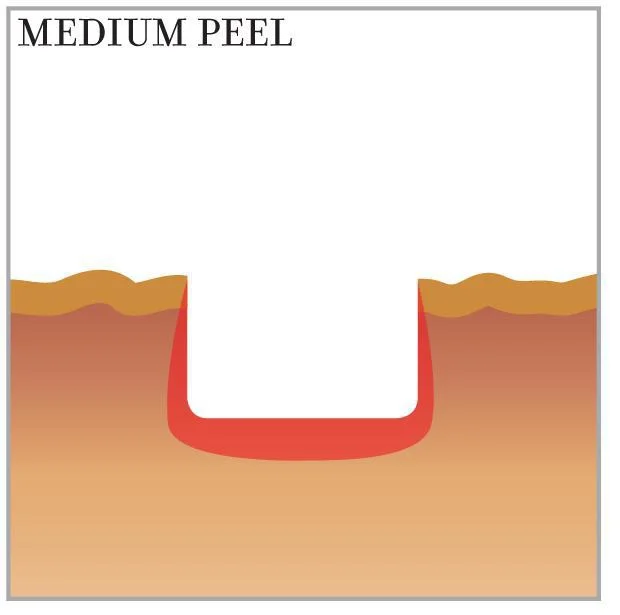
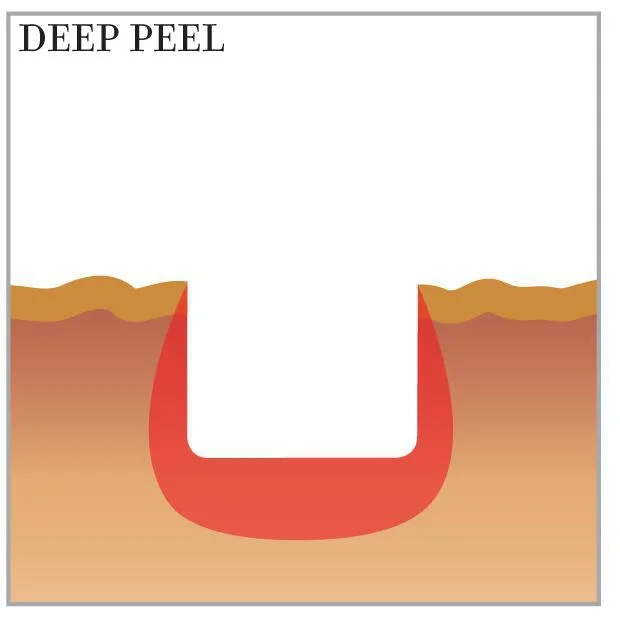
What to Expect After Laser Skin Resurfacing
A burning sensation of the face with associated swelling develops over the first 24 hours and takes about 24-48 hours to resolve. This is a non-invasive procedure, so there is very little recovery time. You will be able to return home on the same day as the procedure. You may experience redness on the skin that may feel similar to a mild sunburn. This may last for around 48 hours. After around 36 hours, the skin will begin to peel. After seven days, you may wish to do a light exfoliation to remove any peeling skin.
You should avoid any exercise for the first 24 hours. Avoid any sun exposure and apply any makeup for the first 48 hours. Avoiding makeup will help reduce the possibility of any acne breakouts. During this period, make sure to keep the skin moisturised and hydrated.
Risks and Potential Complications of Laser Resurfacing
Laser resurfacing is a safe procedure when performed by appropriately trained practitioners. At Centre for Surgery, risks are minimised by meticulous patient selection and thorough pre-procedure preparation. It is very important to undertake skin preconditioning to enhance treatment efficacy.
Potential risks of laser resurfacing
- Post-inflammatory hyperpigmentation
- Excessive burning
- Infection
- Persistent itchiness
- Facial scarring
- Persistent redness
- Herpes virus reactivation
- Post-procedure milia
- Acne breakouts
How Much Does Laser Skin Resurfacing Cost in London?
There are several factors which will impact the final cost of the laser resurfacing procedure:
- Type of laser resurfacing – fully ablative or fractional
- Type of anaesthesia – local anaesthesia or local anaesthesia combined with sedation
- Combination with other treatments such as facelift or blepharoplasty
Why not call 0207 993 4849 and speak to one of our expert patient coordinators, who can give you a rough costing before laser resurfacing?
Remember that price should never be the determining factor when choosing your provider. We feel that safety and quality of service should be your number one priority, and we instil in you the confidence that our team will look after you before, during, and after your procedure to the best of their ability.
Laser Skin Resurfacing in London: Discover Excellence at Centre for Surgery
FAQs
-
What is The Difference Between IPL and Laser Resurfacing?IPL skin rejuvenation and laser skin resurfacing differ from one another in a number of important aspects:
Firstly, IPL is not a laser treatment. IPL skin rejuvenation involves the emission of broadband light of many different wavelengths at high intensity to address different layers of the skin simultaneously whilst sparing normal healthy skin cells. IPL is ideal for improvement of skin tone and texture and for the treatment of a wide variety of skin conditions such as hyperpigmentation, facial redness, broken capillaries, age spots, sun spots and unwanted hair.
Laser skin resurfacing differs from IPL treatment in that it involves the emission of a single wavelength of laser energy to one specific type of skin lesion. There are different types of lasers and each one is specific for treatment of a small number of similar skin lesions. For example, pulsed dye laser and Nd:YAG laser are for treatment of vascular lesions. Q-switched lasers are used for pigmented lesions and tattoos while ablative lasers such as CO2 and erbium lasers are good for treatment of photo-ageing, scars and removal of superficial skin lesions such as moles and warts.
At Centre for Surgery, we offer the full range of laser devices to complement our powerful IPL system. These include ablative erbium and CO2 laser for traditional laser skin resurfacing, non-ablative erbium glass and thulium fibre laser for non-ablative laser resurfacing, pigmented lesions and for darker skin types as well as Nd:YAG laser and pulsed dye laser for both superficial and deep vascular skin lesions such as port wine stains, haemangiomas, thread veins, spider veins and angiomas in any part of the body or face.
Each type of laser has its advantages and disadvantages and your practitioner will advise on the correct type of laser to use for your skin concern at your face to face consultation. -
What Are The Different Types of Lasers Used in Laser Resurfacing?At Centre for Surgery, we offer the full range of laser resurfacing options at our specialist centre in Marylebone.
Laser resurfacing can be carried out using either ablative laser or non-ablative laser:
Ablative lasers include CO2 laser and erbium YAG lasers. CO2 laser used to be traditionally used in a fully ablative mode for significant skin rejuvenation affects. The downside of such an aggressive treatment was the significant risk of scarring that often occurred following treatment and it was only applicable to patients with lighter skin types and under a general anaesthetic. Fully ablative CO2 laser resurfacing is not carried out at Centre for Surgery. Erbium laser is a newer type of ablative laser with gentler effects on the skin and therefore less risks of hyperpigmentation and scarring following treatment. Erbium laser resurfacing can be either fractional or fully ablative. Fully ablative erbium laser resurfacing is commonly performed by our laser dermatologists. CO2 laser or erbium laser can only be used on patients with light skin types.
Non-ablative lasers do not have any affect on the epidermis and exert their affects in the deeper dermal level. The anti-ageing effects following treatment with non-ablative laser are not as impressive when compared with the CO2 or erbium laser. Treatment often requires a number of sessions. Non-ablative laser can be safely used on patients with darker skin types.
At Centre for Surgery we offer two types of fractional non-ablative laser with both erbium glass laser and thulium fibre laser.
All type of laser resurfacing, whether ablative or non-ablative, are easily carried out under local anaesthetic with our without mild oral sedation for comfort. -
What is the Fitzpatrick Skin Classification System and is it Important for Laser Resurfacing?The Fitzpatrick skin classification system is used by dermatologists to decide upon the correct type of laser for use in laser resurfacing treatment. Selection of the correct laser helps to reduce the risk of complications occurring after laser treatment.
Type 1 - this skin type ever tans and always burns
Type 2 - this skin type tans very little and usually burns
Type 3 - this skin type tans to a mild extent and sometimes burns to a mild degree
Type 4 - this skin type always tans to a moderate brown and burns if any are very mild
Type 5 - this skin type tans to a dark brown and the risk of burns is very minimal
Type 6 - this skin type tans to deep brown and burns never happen
Skin types 1-3 are suitable for ablative laser treatments including CO2 and erbium laser. Skin types 3-6 are better suited for non-ablative laser treatments such as erbium glass and thulium fibre laser treatments. -
Who Performs Laser Skin Resurfacing at Centre for Surgery?Laser skin resurfacing is performed both by our highly experienced aesthetic practitioners and also our consultant dermatologists. For the more aggressive and powerful laser treatments, these are performed by one of our dermatologists for optimum safety and effectiveness as a deeper laser peel may require injection of local anaesthetic combined with tablet oral sedation.
-
What Is Fully Ablative Laser Resurfacing?Fully ablative laser resurfacing is an aggressive type of laser treatment performed only by experienced dermatologists with powerful surgical-grade laser devices. There are only a small number of laser surgeons in the UK with the qualifications and experience to carry out fully ablative laser resurfacing.
The treatment is appropriate for a wide range of skin concerns including fine lines and deeper wrinkles, skin laxity, hyperpigmentation, acne scars, sun damage from prolonged sun exposure and pre-cancerous skin lesions such as actinic keratosis. Fully ablative laser resurfacing is a powerful treatment for the prevention of skin cancers of the face by removing actinic keratoses (which could develop into later squamous cell carcinoma). Fully ablative laser is the gold standard treatment for treatment of acne scars and facial skin rejuvenation.
Fully ablative laser resurfacing produces the equivalent of a second degree skin burn during treatment and it is therefore vital that the procedure is carried out by an experienced laser surgeon. Our dermatologists regularly perform many fully ablative laser treatments each year. The results achieved after fully ablative laser resurfacing are permanent and is extremely effective for the treatment of severe acne scarring and severe photo damage from chronic sun exposure.
At Centre for Surgery, fully ablative laser resurfacing is carried out exclusively with the erbium YAG laser. -
Am I a Suitable Candidate for Laser Skin Resurfacing?You will be a suitable candidate for laser skin resurfacing if you wish to improve the appearance of acne scars, fine lines and wrinkles without having to undergo a surgical procedure or resort to using chemicals peels.
-
Who is not an ideal candidate for laser resurfacing?Laser skin resurfacing delivers outstanding results and will significantly improve fine lines and wrinkles and smoothen out acne scars. However, it cannot completely remove deep wrinkles or severe skin laxity with heavy jowl formation and saggy skin. In these cases, you will be referred to one of our expert plastic surgeons for an assessment to determine if a surgical procedure such as a facelift would be more appropriate with your laser resurfacing procedure. For patients with darker skin types, such as dark brown or black skin types (Fitzpatrick type 4-6), laser resurfacing may not be an ideal option. The risk of developing hyperpigmentation during recovery is higher in darker skin types. For all skin types, commencing a skin preconditioning regimen for at least 4-6 weeks before laser resurfacing is very important. Preconditioning consists of prescription-grade skin care products. The preconditioning protocol prepares the skin for the effects of the ablative laser and optimises recovery and treatment outcomes.
-
What Types of Anaesthesia Can be Used for Laser Resurfacing?We provide the most comprehensive range of anaesthesia options for laser skin resurfacing in the UK. Our dedicated outpatient surgical suite at our Baker Street clinic is fully equipped for all the methods below:
Non-invasive methods:
Topical anaesthesia
Cryo anaesthesia (cold air skin cooling)
Inhaled anaesthesia - inhaled anaesthesia is a game changer for optimising patient comfort with laser skin resurfacing. There are no sedative effects, and patients can control the amount of pain relief by simply inhaling the mouthpiece, which delivers a controlled mixture of 50% nitrous oxide and 50% oxygen.
Invasive methods:
Injected local anaesthesia - direct infiltration, nerve blocks and tumescent anaesthesia - where a procedure requires local anaesthesia to be injected, perhaps because a large treatment area will be addressed, often requires the laser surgeon to utilise a combination of techniques. A common combination is a regional nerve block combined with 'horseshoe' tumescent anaesthesia to allow pain-free full-face laser skin resurfacing.
Systemic anaesthesia - if you prefer to be asleep for your laser skin resurfacing procedure, our expert anaesthetists are trained to deliver TIVA general anaesthesia. This means you cannot see, hear or feel any part of the procedure. When you wake up, you may feel a hot sensation in your face, which is common to all anaesthesia methods and is related to the laser itself. There are many excellent treatments to reduce this sensation and give the skin a cooling effect. -
Is Laser Skin Resurfacing Painful?Laser skin resurfacing Is a very well tolerated treatment. Any discomfort felt during treatment is similar to a light pinch of the skin or a rubber band snapping against the skin. Topical anaesthetic is routinely applied prior to ablative Erbium laser skin resurfacing and for more deeper laser peels, local anaesthetic is injected and is often combined with tablet oral sedation for optimum comfort.
-
Is Laser Skin Resurfacing Safe?Laser skin resurfacing is a very safe procedure when performed by a fully trained laser specialist in a CQC-regulated medical environment.
-
How Long Does Laser Skin Resurfacing Take to Perform?Laser skin resurfacing will take around one hour to complete.
-
What are The Side Effects From Laser Resurfacing?Laser resurfacing when performed by a skilled practitioner may still carry a number of potential side-effects which are to be expected following laser treatment:
Infection
Hyperpigmentation
Scarring
Persistent redness -
What Will The Recovery be Like?As this is a non-surgical procedure, you will have minimal downtime following the procedure.
You may experience some redness on the skin similar to a mild sunburn. This may last up to 48 hours.
After 36 hours, you may notice the skin will start to peel. -
Will I need more than one laser resurfacing treatment?For most patients, laser resurfacing can treat most skin issues in only one treatment. The final results may not become apparent until six months after treatment, particularly after deep laser resurfacing. Some skin conditions, such as acne scarring or more severe skin ageing, are notoriously difficult to treat and may require several treatments for good results. In many cases, skin resurfacing options include milder chemical peels as a second treatment after a first laser resurfacing treatment to 'fine-tune' the result. Prescription-grade skin care products after laser resurfacing (Obagi Nu-Derm) will help to enhance the result further. A single light erbium micro-peel is equivalent to six microdermabrasion sessions.
-
How Many Laser Resurfacing Treatments Will I Need to Obtain Results?Most fractional laser resurfacing treatments require about 3 treatments to achieve great results but the exact number of treatments is based on the degree of photoageing you have. Your practitioner will advise you on the best treatment approach at your consultation.
-
How Long Do Results Take to Appear After Having Laser Resurfacing?The healing after laser resurfacing takes about 5-7 days but this is dependent on the aggressiveness of the laser treatment. More powerful treatments will result in a longer period of downtime. In most cases however, the skin will begin to look more rejuvenated almost straightaway. You should expect to see improvements even after one treatment. The quality of the skin continues to improve due to remodelling of collagen and elastin over the next 3-6 months.
Optimum results after laser resurfacing are seen when patients undertake a full course of treatments resulting in often dramatic treatment results which may significantly reduce the requirement for more invasive treatment such as a facelift. Improvements in skin texture and tone along with a significant reduction in lines and wrinkles are commonly seen. -
Can Laser Resurfacing be Combined with Other Treatments?Although laser resurfacing is commonly combined with other facial rejuvenation treatments such as eyelid surgery or a facelift, our practitioners prefer to carry out standalone laser resurfacing after facial surgery to reduce the risk of potential complications and achieve better results.
-
Can laser resurfacing be combined with a facelift?Fractional laser resurfacing can be combined with a facelift procedure in certain circumstances, such as a mini facelift. There is, however, a potential risk of laser on the newly draped skin after a facelift.
At Centre for Surgery, we always recommend having laser resurfacing, ideally after you have fully recovered from your facelift procedure, for improved safety and better overall treatment outcomes. -
What Other Aesthetic Rejuvenation Treatments are Offered at Centre for Surgery?Centre for Surgery offer the full range of aesthetic skin rejuvenation treatments at our Baker Street clinic.
Treatments include:
- Morpheus8
- Laser resurfacing
- Facial injectables
At your consultation with one of our aesthetic practitioners, recommendations on the best treatment for aesthetic rejuvenation will be made after taking a full medical history, examining your skin and learning about your needs and preferences.


